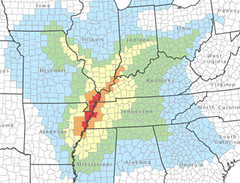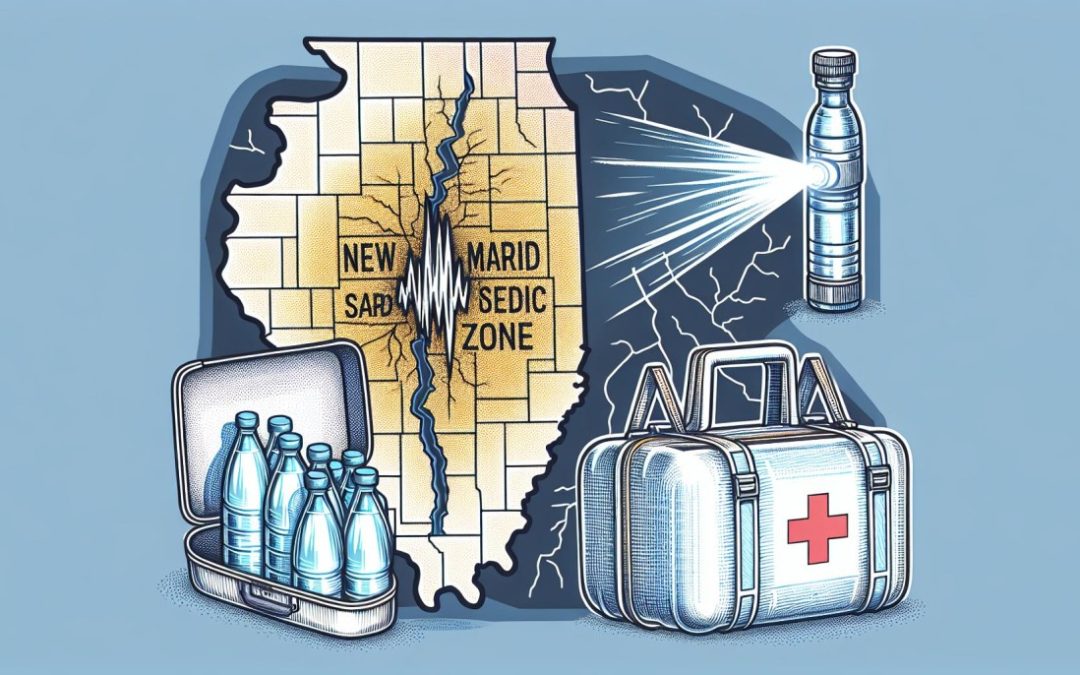EARTHQUAKE……did you feel it? On March 28th the ground was shaking very near us. There was more than a breeze in Breese, IL.
Did you know that the quiet fields and bustling cities of Metro East Illinois are not strangers to the earth’s rumblings? It’s a surprising fact that catches many off guard. Imagine sitting at home, enjoying a peaceful evening, when suddenly the ground beneath you starts to shake.
It’s unsettling, isn’t it? That’s the reality for residents in this area, where earthquakes, though not frequent, are a part of life. In this article, I’ll dive into the seismic activity of Metro East Illinois, offering insights into past events and what they might mean for the future.
You’ll find out why it’s important to be aware and prepared, even in places where earthquakes aren’t top of mind. Stick around, and let’s explore this unexpected aspect of life in Metro East together.
Latest Earthquakes in Metro East Illinois
Recent Activity:
I’ve recently been thoroughly scouring to bring you the latest on seismic activities in Metro East Illinois. Just last month, we experienced a couple of tremors felt across the region.

Though mild, these events remind us that our area isn’t immune to the earth’s movements. For instance, a 2.8 magnitude earthquake surprised residents one quiet evening. Even though it didn’t cause significant damage, it certainly made its presence known and became a topic of discussion in local online forums and community gatherings.
United States Geological Survey (USGS)
The USGS provides a wealth of information, not just on recent seismic events but also on historical ones. According to their records, Metro East Illinois has had its fair share of shakes. The USGS’s detailed maps and data collection have been invaluable in understanding the patterns and potential hazards.
Their real-time earthquake tracker showed the same 3.2 magnitude quake, giving credence to the anecdotal experiences many of us felt. It’s fascinating, and a bit unsettling, to see how our region fits into the broader seismic activities across the country.
Typical Magnitude:
When we dive into the specifics, the earthquakes in Metro East Illinois generally fall on the lower end of the Richter scale. Most of the tremors we’ve felt over the years hover around 2 to 3.5 in magnitude.
While these numbers might seem small, especially when compared to the catastrophic quakes in other parts of the world, they’re still significant enough to stir our community’s awareness and preparedness. Here’s a quick view of the magnitudes we’ve encountered:
| Magnitude Range | Frequency |
|---|---|
| 2.0 – 2.9 | Common |
| 3.0 – 3.5 | Less Common |
| > 3.5 | Rare |
It’s quite clear that while Metro East Illinois doesn’t frequently experience the ground-shaking events seen in more seismically active areas, we’re not entirely off the hook. The records demonstrate that the possibility, albeit small, exists and it’s something we should attentively consider, especially in our community planning and personal preparedness strategies.
Earthquakes in this area tend to be relatively small in magnitude.
When I began exploring the seismic activity in Metro East Illinois, I was keen on understanding the historical instances and the nitty-gritty details like the frequency and magnitude of these events. The more I delved into the data and personal anecdotes, the clearer the picture became.
Earthquakes here, while not uncommon, tend to be on the milder side, but that doesn’t mean they’re not worth our attention.
Frequency:
Illinois sits in an interesting spot geologically. We’re not positioned atop a major fault line like California with its infamous San Andreas Fault, but that doesn’t mean the ground beneath us is completely still. Through my research, I’ve found that Illinois experiences a moderate number of earthquakes. They’re not an everyday occurrence, but they’re not exceptionally rare either.
Illinois Experiences a Moderate Number of Earthquakes Compared to Highly Active Zones
The United States Geological Survey (USGS) has been my go-to resource for piecing together the puzzle of Illinois’ seismic activity. What’s fascinating is comparing our state to areas known for their frequent, often devastating shakes. We’re considerably quieter by comparison, but it’s a reminder that the earth beneath us isn’t as static as it seems.

Most Are Minor, But Some Larger, Potentially Damaging Earthquakes Have Occurred Historically
Diving deeper into the data, it’s clear that while most of the earthquakes we experience hover in the less alarming range of 2 to 3.5 in magnitude, we’ve had our share of surprises. Historical records and geological studies point to instances where the land got a bit more aggressive, reminding everyone of the latent power resting underneath.
| Year | Magnitude |
|---|---|
| 1804 | 5.1 |
| 1968 | 5.4 |
| 1987 | 5.2 |
These numbers tell a story. They remind us that while we’re used to minor tremors, the potential for something bigger always looms. It’s a nudge towards preparedness and understanding, an invitation to not be complacent just because our earthquakes tend to be smaller.
Reflecting on this, I’ve found a newfound respect for the subtle ways our earth communicates its strength and fragility. In Illinois, our seismic story is one of moderate activity and minor quakes, but it’s peppered with historical events that stand as a testament to the power beneath our feet.
We might not face the same seismic challenges as those living in famously active zones, but our experiences add valuable chapters to the broader narrative of understanding and respecting the dynamic planet we call home.
Notable Historical Earthquakes
While talking about earthquakes in Metro East Illinois, it’s essential to delve into some historical examples that highlight the region’s seismic activity. By understanding these past events, we gain insight into what might be expected and why preparedness remains crucial.
The 1968 Southern Illinois Earthquake
One of the most significant tremors in Illinois’ history struck in the early morning hours of November 9, 1968. The earthquake, centered near the village of Dale in Hamilton County, registered a magnitude of 5.4, making it one of the largest to ever hit the state.
I remember reading accounts of residents waking to a rumbling that felt as if a freight train was barreling through their homes. The quake caused significant structural damage to buildings, cracked roads, and even altered the flow of some wells.
The 1968 earthquake serves as a stark reminder of the seismic potential lurking beneath Illinois’ surface. While no fatalities were reported, the event caused millions of dollars in damages and left a lasting impression on those who experienced it.
- Buildings: Numerous buildings suffered structural damages, including cracked foundations and collapsed chimneys.
- Infrastructure: Roads were cracked, and some railway lines were temporarily unusable due to misalignment.
- Community Impact: Panic and confusion were widespread, leading to a renewed focus on earthquake preparedness in the region.
This earthquake underscored the necessity for building codes that could withstand such events and highlighted the importance of community awareness and preparation for future quakes.

The events of 1968, alongside other seismic activities in the region, tell a tale of an ever-present threat that’s often overshadowed by the area’s tranquility. It’s a powerful reminder that the earth beneath our feet holds a force capable of significant change, urging us to respect its power and prepare for its eventualities.
Preparing involves understanding the risks, retrofitting homes and buildings to withstand shaking, and having emergency plans in place should another significant quake strike. By learning from the past, we can better safeguard our communities against future seismic surprises.
Causes of Earthquakes in Illinois
Not on a Major Plate Boundary
I often find myself marveling at the fact that Illinois, despite not being situated on a major tectonic plate boundary like California or Japan, still experiences its share of earthquakes. This curiosity led me to dive deep into what’s going on beneath the surface.
See, the Earth’s crust is made up of several gigantic plates that float on the semi-fluid layer right underneath them. Now, most earthquakes around the world occur at the edges of these plates. However, Illinois lies smack in the middle of the North American Plate. So, you’d think we’d be spared the Earth’s rumblings, yet history tells us a different story.
Primary Causes
Intraplate Earthquakes
When trying to get my head around why we feel the ground shake, I discovered that intraplate earthquakes were a key player. These are quakes that happen within the interior of a tectonic plate – much like most of Illinois. What’s happening down there?
Our planet’s crust isn’t just sitting still; it’s constantly under stress. This stress can be from the enormous forces exerted as plates push and pull against each other or from the weight of miles-thick ice sheets that once covered the land.
Over time, these stresses can cause the crust to crack and slip along old, pre-existing fault lines, releasing energy in the form of an earthquake. It’s fascinating to think that the ground beneath us bears the scars of ancient geological histories, silently telling tales of a much more dynamic Earth.
Human-Induced Activities
And then there’s the human factor. It might sound like a plot from a science fiction movie, but our activities can, in rare cases, trigger earthquakes. Mining operations, for example, can alter the stress on the crust directly beneath us, sometimes leading to small tremors.
More commonly talked about these days are the effects of deep fluid injection, a process used in oil and gas production as well as in the disposal of wastewater. Injecting fluids into deep wells increases the pore pressure in the Earth, which can, under the right conditions, cause slipping along faults, similar to naturally occurring earthquakes.
Realizing that we’re not entirely passive residents on this planet but indeed capable of shaking the very ground we stand on adds a layer of responsibility to how we interact with our environment. It’s a reminder that understanding the causes of earthquakes, even in a place like Illinois, involves peering into both the natural world and the impact of human actions.
The New Madrid Seismic Zone and Illinois
Location
The New Madrid Seismic Zone (NMSZ) might not be a household name, but it’s a significant geological feature that spans several states. Its reach extends across parts of Missouri, Arkansas, Tennessee, Kentucky, and, crucially for us, Illinois.
This sprawling seismic zone is tucked away from the edges of the large tectonic plates, yet it’s a hotbed for earthquake activity right in the heartland of America.
Historical Significance
I’ve always been fascinated by the stories from the past, and the NMSZ has a history worth noting. It was the site of some of the most massive earthquakes ever recorded in the continental United States. Back in 1811 and 1812, this zone produced a series of very large tremors.
The echoes of these quakes tell a tale of a time when the ground shook so violently, it altered landscapes and the course of rivers. These historical quakes serve as a reminder of the power hidden beneath our feet and the potential for future seismic events.

Potential Impact on Illinois
Living in Illinois, it’s easy to think we’re safe from the dramatic natural disasters often associated with the West Coast’s infamous Pacific Ring of Fire. However, the truth is a bit more complicated. While the epicenter of the NMSZ lies in neighboring Missouri, the seismic waves from a large earthquake there could propagate far and wide, reaching Southern Illinois with significant strength.
This means that communities in our region must stay informed and prepared for the possibility of earthquakes, despite our distance from the most active fault lines.
Important Notes
Given the unpredictability of earthquake activity, especially in a zone like the NMSZ, it’s crucial for residents of Illinois and the surrounding states to be aware of the risks and to take practical steps toward preparedness. Here are a few pointers I’ve picked up:
- Always have an emergency kit ready with essentials such as water, food, and first aid supplies.
- Secure heavy furniture and appliances to the walls to prevent them from tipping over during shaking.
- Familiarize yourself and your family with safe spots in your home, such as under sturdy tables or against interior walls, away from windows.
Understanding the seismic activity in our region isn’t just about being prepared; it’s also about appreciating the dynamic nature of the planet we call home. The New Madrid Seismic Zone’s history and potential for future activity serve as a vivid reminder of the earth’s ever-changing landscape.
Whether it’s through historical accounts or modern-day science, there’s so much to learn and so many reasons to stay intrigued by the world beneath our feet.
Earthquake prediction is not yet reliably possible
Living in or near the Metro East Illinois area means we’re in a unique position. The New Madrid Seismic Zone’s history reminds us that we’re not immune to the Earth’s shakes and shifts. While we can’t predict when the next big one will hit, we can certainly arm ourselves with knowledge and readiness.
I’ve shared some practical tips on how to stay prepared because, at the end of the day, understanding and respecting our planet’s dynamic nature is crucial. Let’s not wait for the ground to remind us of its power. Instead, let’s stay informed, prepared, and safe. After all, it’s better to be proactive than reactive when it comes to natural disasters.
Closing
We hope you are enjoying these articles and are willing to continue to follow along as we share our adventures of learning about life in southern Illinois, This is an exciting area and we are so happy to be part of this area. Our lives are being fulfilled by the people we are meeting. Bruce & Karen.
This website is a participant in the Amazon Services LLC Associates Program, an affiliate advertising program designed to provide a means for sites to earn advertising fees by advertising and linking to Amazon.com and affiliated sites. As an Amazon Associate, I earn from qualifying purchases.
We’re Bruce and Karen Carlson. We recently moved to the Metro East area of Illinois. This area is east of St. Louis from the Mississippi River north to Alton, east to Carlyle, back south to Waterloo and the Mississippi River, finally north to Columbia. The center is Fairview Heights, Swansea, Belleville, Shiloh, and O'Fallon. Not to be forgotten is Southern Illinois University (SIU) in Edwardsville. It’s a whole new world out there. Our goal with this website is to share our exploration of the Metro East area. As we find businesses and services we use in our daily lives, we’ll share how these businesses and services have helped make our lives better and easier to live.
We’re calling our move to the Metro East area retirement, but we’re not quite sure what that means. By sharing our story with you, we hope you too will gain a better sense of what the Metro East area has to offer and how their businesses and services can improve your lives and build a better community.


